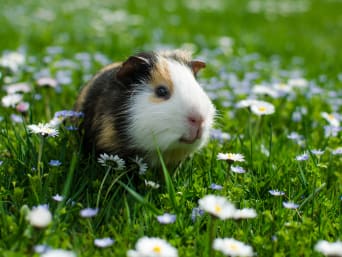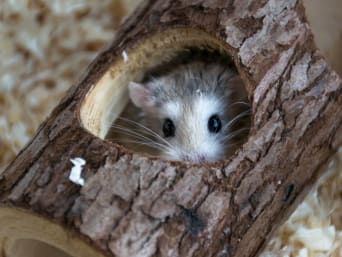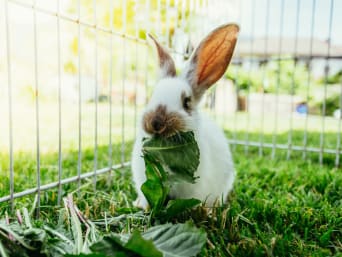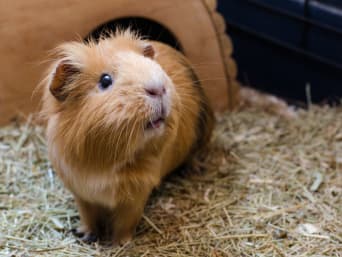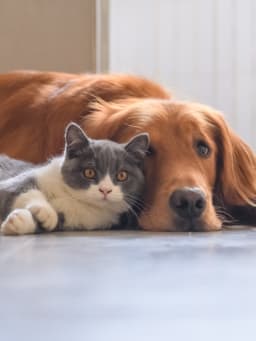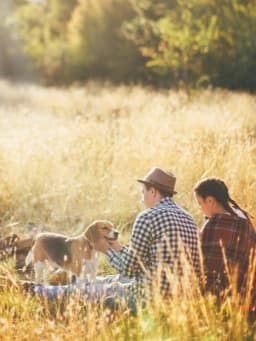Owning small pets: how to care for a hamster, rabbit or guinea pig
Big round eyes, cute twitching whiskers and soft fur: small animals such as rabbits, guinea pigs and hamsters are simply adorable. However, these small pets also have special care requirements and should not be regarded as cuddly toys. To ensure that their needs are met, it is important to find out exactly what they will need before you buy one. We will show you whether a small animal is a suitable pet for you and provide you with information on how to look after guinea pigs, rabbits and hamsters.
Contents
Information on how to keep hamsters, guinea pigs and rabbits
Pet care tips for small animals: is a small pet suitable for me?
Small animals are thought to be particularly child-friendly due to their cuddly appearance and reserved nature. Because of their small size, they are also considered low maintenance pets compared to dogs and cats. However, you should be aware that small animals need to be kept under specific conditions to keep them healthy. You will need ample space, enough time to care for them and a lot of patience when getting to know your new flatmate.
To avoid mistakes in their care and to ensure the well-being of your small pet, it is important to understand that hamsters, guinea pigs and rabbits are not easy-care cuddly toys. Therefore, you should clarify a few fundamental questions before purchasing a pet:
What are your expectations? Small animals are quite reserved and don't really like being stroked or picked up. If you want an affectionate, cuddly animal, you should consider a dog or cat.
How much time do you have to care for your pet? You will need time to slowly gain their trust. You will need around 10 to 15 minutes a day for feeding and cleaning their enclosure. You will also need to allow more time for regular, thorough cleaning of their home.
How much space do you have to accommodate your pet? It is often underestimated how much space a small animal needs due to their small size. However, small animals need enough space to freely run around. They will also need sufficient areas to retreat to, hiding places and, if necessary, climbing options. An additional area where they can run about in is recommended for guinea pigs and rabbits.
Would you like to keep more than one pet? While hamsters are solitary animals, guinea pigs and rabbits need company of their own kind to feel happy. These social contacts are important and can't be replaced by spending time with their owner.

Many types of small rodents are crepuscular or nocturnal and should not be disturbed during their rest periods during the day to prevent them from becoming snappy or aggressive. Hamsters and chinchillas usually sleep the whole day and only wake up when it gets dark. Sometimes fancy rats can also be active in the early morning or late in the afternoon.
Pet care tips for small animals: general care
In addition to the specific housing conditions that rabbits, guinea pigs and hamsters need, there are some general requirements that you should be aware of. These factors also determine whether a small animal is a suitable pet for you.
Keeping small animals: information on space requirements
Guinea pigs, rabbits and hamsters may be small, but they still need enough space to satisfy their natural urge to move and run about. Find out in advance how many square metres of space your small animal will need. As a general rule, the more space the animals have, the better.
Also, look for a suitable place in your home for the enclosure where your animals will feel as undisturbed as possible. Therefore, it is not a good idea to put a cage in your children's room. Children playing or teenagers listening to loud music can wake these sensitive animals and ruin their sleeping pattern. On the other hand, a nocturnal hamster can also disturb your children's sleep by rustling in its cage.
Small pets for children: things to bear in mind
Children are easily fascinated by these fluffy little animals. However, rodents and rabbits are only suitable as pets for children from ages 8 to 10 and upwards. A great deal of responsibility and patience is required to gain the animals' trust. Picking up or holding your pet against their will puts them under enormous stress and should be avoided.
Small animals are not only easily frightened, but they are also very delicate. Being unintentionally rough with them or a fall can lead to serious injuries. Sometimes you will have to pick up your little pet, for example to visit the vet or to check on its state of health. Approach it slowly and lure the animal with a few treats if necessary. It is best to hold the small animal gently with both hands and make sure you have a secure grip so that it cannot escape and injure itself.
Pet care tips for small animals: how to handle small pets with care
Be patient and allow time for hamsters, guinea pigs and rabbits to get used to their new home. Over time, they will get used to their owners. With patience, they may become tame and can then be fed directly from your hand. If possible, however, do not pick them up or place them on your lap, as this will break the trust you have built with them.
Some animals will allow you to stroke them if they feel comfortable in a familiar environment and if they have enough space to spend time by themselves and do not feel pressured. Other animals will remain skittish for their entire lives. Before you buy a rodent or rabbit, you should be aware that they have an instinctive escape response and can often only be observed. You should be aware of this before you purchase a small animal.

Despite having incisors and their love of gnawing, rabbits are not actually rodents. They belong to the rabbit family and are therefore merely related to rodents.
Rabbit care: tips on how to look after your rabbit
Cute and fluffy rabbits are very popular as pets. Keeping them in an appropriate environment, means giving them enough space to satisfy their natural urge to move about. These long-eared companions are a social species and prefer to live in groups. A hutch or cage is not appropriate housing, even if for just two rabbits. Instead, according to pet care authorities, housing and equipment for keeping rabbits should fulfil the following criteria:
If possible, an open enclosure with at least 6 m² floor space for two rabbits (+ outdoor space for running about in), for each additional rabbit you will need to increase their enclosure by 20 %
One shelter per rabbit
Stable drinking and feeding bowls
Bedding, e.g. sawdust or hemp bedding, and straw bedding if necessary
A secure hay rack, ideally closed at the top
Hiding places and toys
Whether inside your home, on your balcony or in the garden, your rabbit’s spacious enclosure should be connected to a run so that it can hop around undisturbed. Other pets such as dogs or cats should not have access to this area and cables, cleaning products or poisonous plants must be kept out of reach.
When keeping rabbits outdoors, it is important that your pet’s enclosure is secure from the outside, that it can’t escape and also offers a warm shelter. You should only allow your rabbit to run around in a secured garden with a fence, and if possible under supervision.

Although rabbits and guinea pigs are very social animals, keeping them together is not recommended. The body language and behaviour of the two species are quite different, which can lead to the animals feeling stressed and irritated.
There should be enough hiding spaces and options to keep them occupied in their enclosure. Branches and twigs, tunnels made of willow or cork, or feeding toys provide sufficient variety. These curious little animals enjoy having platforms and also using them as lookouts. You can also provide them with a digging box, which many rabbits enjoy using.
In addition to your pet’s housing necessities, you should inform yourself about the possible costs involved if you want to keep rabbits. You can find an overview of what to keep in mind when getting a pet in the following article: Getting a pet.
Guinea pig care and housing
Guinea pigs are extremely sensitive and shy animals that are easily scared off by unwanted petting. Nevertheless, they are by no means solitary animals. As a social species, they need at least one or two companions of their own kind in order to be happy and not get bored. According to pet care authorities, species-appropriate keeping is only possible under the following conditions:
An enclosure with at least 2 m² for up to four animals (+ a space to run about in), for each additional animal the enclosure should be enlarged by 0.5 m²
One shelter per animal
Stable drinking and feeding bowls
A safe hay rack
Bedding, e.g. sawdust, covered with straw if necessary
Hiding places and toys
As with rabbits, a sufficiently large enclosure with the option to roam free is a must for guinea pigs. These small animals love to run about and explore their surroundings, so a run of 2 metres in length is recommended.
With tunnels made of willow twigs, roots and safe platforms, you can make your guinea pig’s enclosure more interesting and offer your guinea pigs variety and new places to explore.
Guinea pigs can be kept indoors and outdoors. With both options, you should ensure that they are adequately secured and remove typical sources of danger (cables, toxins, etc.) beforehand. Also note that guinea pigs do not cope well with heat. Therefore, the enclosure should not be placed next to a heater or in direct sun. If you want to keep your guinea pig outside, you should make sure that no intruders can get into its enclosure. You also shouldn’t approach your guinea pigs unexpectedly from above as this may frighten them.
Before you decide on a guinea pig as a pet, you should get an idea of the costs of keeping guinea pigs. You can find more information on what you will need in the following article: Getting a pet.
How to care for a hamster: an enclosure, equipment and activities that will keep your hamster happy
In contrast to guinea pigs and rabbits, hamsters are crepuscular and nocturnal loners. They consistently defend their territory and food supply, which is why they do not get along with their own kind outside of mating season. For this reason, hamsters should be kept individually to prevent fighting. According to pet care authorities, a golden hamster requires the following basic housing and equipment for species-appropriate keeping and a varied daily routine:
An enclosure with at least 1 m² of floor space, a minimum of 70 cm height, several interconnected levels and a layer of bedding at least 30 cm high
A multi-chamber house made of wood or clay
Bedding, e.g. sawdust, hemp bedding or similar, mixed with hay and straw to enable tunnelling
A sand bath filled with chinchilla sand for coat care
A water trough and food bowl if necessary
A hamster wheel with closed sides and a diameter of 25 to 30 cm
A salt lick to provide minerals
Your hamster will need shelter in the form of tubes and roots, which in turn can also stabilise tunnels that they have built. Also, there should always be enough safe materials available for gnawing and nesting (e.g. paper, unprinted cardboard or branches).
Hamsters also have a strong urge to move, which they can satisfy on a hamster wheel. Choose a hamster wheel that is big enough so that your little pet can run with a straight back. To avoid injuries, the running surface and the back wall of the hamster wheel should be closed.
Any free open areas for your hamster should be limited and well secured. This will prevent your rodent from crawling under the furniture.
If you are wondering what you should keep in mind when getting a hamster, you can find an overview in our article: Getting a pet.
Conclusion: small pets are interesting to observe but not to cuddle
Many budding pet owners see small animals as "easy" starter pets that are particularly suitable for children. However, rodents and rabbits are sensitive animals that require a lot of patience and care. Children should be closely supervised and guided when handling small animals. This will prevent the animal from becoming stressed and your child being disappointed. If you want to keep a small animal as a pet, you should first consult various sources on how to keep and care for it. This will enable you to care for your pet according to its needs and support its long-term well-being.
______________________________________________
References and further information
https://www.a-z-animals.com/blog/how-to-choose-the-correct-wheel-for-your-hamster-size-type-pros-and-cons/
(Last accessed on 19.02.2024)
https://www.birdexoticsvet.com/post/free-roam-rabbit-tips
(Last accessed on 19.02.2024)
https://www.omlet.co.uk/guide/guinea_pigs/should-i-get-guinea-pigs/time_requirements/
(Last accessed on 19.02.2024)
https://www.rabbitwelfare.co.uk/space-recommendations/
(Last accessed on 19.02.2024)
https://www.rspca.org.uk/adviceandwelfare/pets/rabbits
(Last accessed on 19.02.2024)
https://www.rspca.org.uk/adviceandwelfare/pets/rodents/guineapigs
(Last accessed on 19.02.2024)
https://www.rspca.org.uk/adviceandwelfare/pets/rodents/guineapigs/environment
(Last accessed on 19.02.2024)
https://www.rspca.org.uk/adviceandwelfare/pets/rodents/hamsters
(Last accessed on 19.02.2024)
https://www.therabbithouse.com/indoor/designing-rabbit-cage.asp
(Last accessed on 19.02.2024)
The image sources in this text are in chronological order
Cover photo: iStock.com/Galyna0404
1. Image in text: iStock.com/Anyarnia
2. Image in text: iStock.com/Patrick Daxenbichler
3. Image in text: iStock.com/DevMarya
